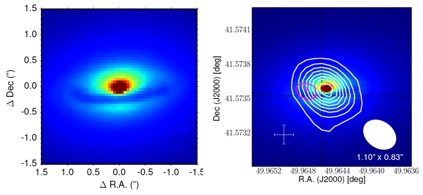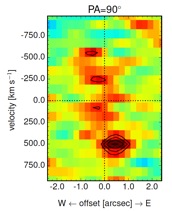News
Is the black hole in NGC 1277 really obese?
It is well known that each galaxy hosts in its nucleus a super-massive black hole, of mass equal to 0.2-1% of its bulge mass. Recently a few exceptions of over-massive black holes might have been discovered, although this is still under debate. In the lenticular galaxy NGC 1277 in the Perseus cluster, the largest black hole ever has been claimed, through stellar kinematics measurements, to be about 50% of its bulge mass! Some astronomers have contested this value, which could be due to a wrong model of the stellar kinematics, in addition to an under-estimation of the bulge mass, such that the NGC 1277 black hole could still follow the black-hole/bulge-mass relation, although with some scatter. An international team of astronomers, has obtained for the first time a map of the molecular gas in the nucleus of this galaxy, and the gas kinematics, which can provide mass models more straightforwardly than the stellar kinematics, favors a large black hole mass, well above the black-hole/bulge-mass relation.
 |
| Left: Optical HST image of the central 3''×3'' region of NGC 1277. The dust lane obscuring the central region is clearly shown: it is almost edge-on, with an inclination of 75°, and has a radius of 0.9 arcsec (=320 pc). Right: superposed on the HST image, are the white contours of the millimeter continuum detected, and in red, the CO(1-0) contours, showing essentially the peak of emission in the dust lane, east of the nucleus. |
For the last twenty years it has been suggested that the mass of super-massive black-holes (BH) in galaxy nuclei scales with the mass of the host galaxy bulge/spheroid at a fixed fraction of around 0.2 to 1%. This relation has been interpreted as a co-evolution of black holes with their galaxy hosts. The few known black holes that have been claimed to be too massive compared to their host galaxies are particularly interesting objects in the context of black hole and galaxy evolution.
The most extreme case for harboring an ultra-massive black hole so far is NGC 1277, a compact lenticular galaxy with a stellar mass of 1.2 × 1011 Msun in the core of the Perseus Cluster, about 3.8 arcminutes away from the central cluster galaxy NGC 1275. In 2012, Remco van den Bosch and collaborators found a mass of 1.7 × 1010 Msun for the black hole in this galaxy, by modeling the stellar kinematics measured in long-slit spectra. This result has been confirmed recently by Yıldırım et al (2015) although with a slightly lower mass of 1.3 × 1010 Msun. Such a huge black hole-to-bulge mass ratio (about 100 times the expected value), could indicate that the galaxy’s stellar mass was truncated through processes in the harsh environment of the galaxy cluster after the black hole had formed. This would then shed light on formation scenarios.
However, the high black hole mass of NGC 1277 has been controversial. The derivation of the mass was put into question by Emsellem (2013), proposing a different interpretation of the stellar kinematic measurements. Stellar velocities are often dominated by dispersion and anisotropic systematic motions, complicating any kinematic analysis. The mass-to-luminosity ratio of the stars in the center could also be enhanced, which would reduce the required black hole mass. Finally a bar (oriented towards the observer) could also produce biases in the motions of stars towards the center.
Gas kinematics can provide an independent and clearer view of the velocities in the center of NGC 1277. Indeed the gas is cold enough not to be dominated by velocity dispersion, and a sophisticated model is not required to derive the mass enclosed in a given radius. One of the largest problems, though, is that NGC1277 is a lenticular galaxy, which usually possess very little gas, and that it is in the center of a galaxy cluster, where ram-pressure stripping makes galaxies even more gas deficient.
 |
| Position-velocity diagram of the CO(1-0) emission along a 0.72-arcsec-wide slit oriented in east-west direction. Contours start at 4 sigma and increase in steps of 1 sigma. |
Nevertheless the astronomers have undertaken a deep search for molecular gas, with the CO(1-0) emission line tracer, deeply integrating with the IRAM interferometer . There is a small amount of gas, 1.2 × 108 Msun about 0.1% of the total stellar mass, but sufficient to derive the velocity. The spatial resolution of 1 arc second of the gas observations are not enough to have a good map, but the peak of the emission is clearly in the east side of the nucleus, in the dust lane.
The position-velocity diagram and the total CO(1-0) spectrum have been interpreted within simple mass-models, taking into account the previously published optical photometry. If the mass-to-luminosity ratio (M/L) is taken as usual for galaxies of this type, the black hole mass derived is indeed compatible with the high value found by van den Bosch et al (2012), i.e. 1.7 × 1010 Msun. If a higher M/L=10 is adopted, the black hole mass could be as low as 5 × 109 Msun. However, even in this case, the black hole in the NGC 1277 nucleus is still 15% of its bulge mass, indeed actually obese!


.jpg)